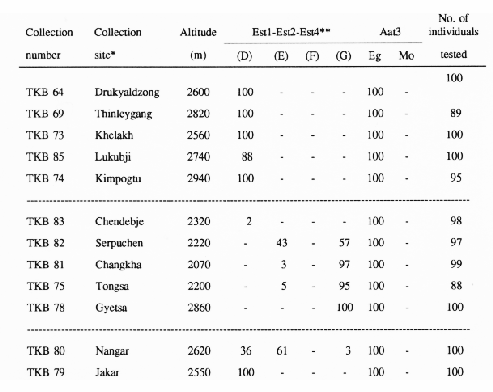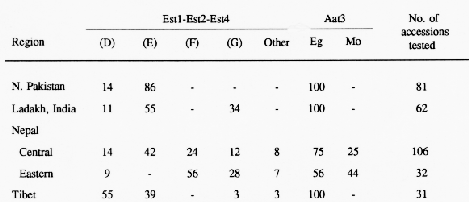

On Bhutanese barley, we possess very incomplete information. Fortunately, I took an opportunity to visit Bhutan in September of 1991 and collected barley seed samples from farmers. Barley was grown in highlands more than 2,000 meters above sea level from April to October as a summer crop, and the samples were of the naked type.
For examining isozyme variations in esterase and aspartate aminotransferase, 100 kernels per sample were sown in a sand bed, and the seedlings were grown under 12 h illumination in a growth cabinet kept at 18°C for 10 days. Crude extract from the first leaf of each seedling was used for two different systems of starch gel electrophoreses.
Table 1 indicates genetic variations in the two isozymes within population. For esterase isozymes, three genotypes which consisted of allelic combinations at the complex loci, Estl, Est2, and Est4, were detected. They were Ca-Un-Nz (D), Pr-Fr-At (E), and Pr-Fr-Su (G). Some of the populations were homogeneous, while the others were heterogeneous. Most of the populations in western region of Bhutan (TKB 64-74) were homogeneous for type D, whereas those in central region (TKB 83-78) were heterogeneous, possessing type G as the major genotype. In eastern region, one population (TKB 80) was heterogeneous, and the other one (TKB 79) was homogeneous for type D. For aspartate arninotransferase, all of the populations were homogeneous, carrying the Eg allele at the Aat3 locus.

For comparison of isozyme variations in Bhutanese barley, Table 2 shows frequencies of genotypes for the two isozymes in naked barley collections from the Himalayan regions. Barley collections from Bhutan were similar to those from Tibet and Ladakh of northern India. All of their barley collections were naked, and did not possess type F for esterase isozymes and the Mo allele at the Aat3 locus for aspartate aminotransferase, which was frequently detected in Nepalese barley. From these results and historical evidence, it may be concluded that several types of barley seed were introduced to Bhutan by Tibetan immigrants and that the seeds were mechanically mixed with those carrying different genotypes. Reference: Konishi, T., and S. Matsuura. 1991. Geographic differentiation in isozyme genotypes of Himalayan barley (Hordeum vulgare). Genome 34:404-409.
